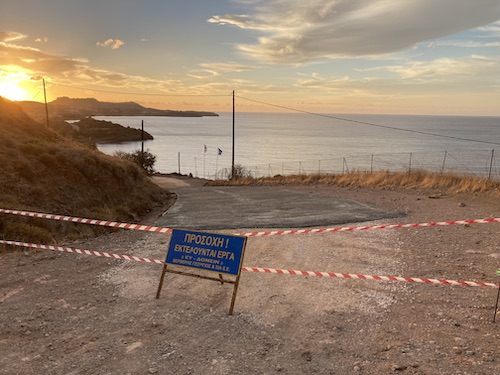One of the most popular tourist attractions on Lesvos is the village of Molyvos, with its medieval castle towering above. Connected by meandering picturesque little streets, the houses are glued to the mountain, around it are many hotels, while the B&B’s are mainly within the village itself. There also is a big community of ex-pats who live in Molyvos during more than only the warm months, keeping the village lively.
Nobody seems to have foreseen the deluge of tourists during last summer. You would think that an island municipality should know how many visitors the charter flights and boats were bringing to the island. It’s as if the ferries with loads of Turks and their big fancy cars were not anticipated and that the charters from Turkey and Europe appeared from nowhere.
The population influx caused traffic jams from hell in Mytilini and elsewhere on the island and long rows of hungry people had to wait to get food in Molyvos where one could barely find a table without a reservation. Many a tourist said they’d never come back to this overcrowded village. It is clear that the municipality wasn’t prepared at all for all those crowds shuffling through its streets looking for food, drinks and amusement.
The municipality also showed itself at ‘its best’ with the water management in Molyvos. For a long time only one of the two water reservoirs was working and suddenly, at the beginning of the summer, it was realised that the heat was on its way, the village was full and lots of water would be needed.
The municipality used a big water truck to lighten this problem a bit. The truck, pumping up all the ground water, was stationed ‘strategically’ before a dangerous curve on the main road leading into Molyvos. But even so, the upper parts of the village were without water for half of the summer, and this year the summer was very long. It is also unknown how many accidents that truck caused.
It may be that the municipality did not have time to consider these urgent matters during the previous winter. Imagine— laying new water pipes leading up to the castle in June, causing the road for days to be closed.
Now the damage is done, most of the tourists are gone, the locals are tired. There are very few restaurants and shops open now: even though there is a push to encourage tourism in autumn. Visitors coming off-season had better prepare themselves for few services.
Yesterday, along with friends, I visited the Sanctuary of Mesa, where we were not the only visitors. There were more people there than in Skala Kallonis, where most restaurants and cafes were closed (some with dirty curtains obscuring the windows, making it hard to imagine that they actually served food in the summer). However, just opposite the church, a lively chattering of people was heard—where hungry visitors were welcomed to the new restaurant To Mezen, with a surprising menu and lovely food.
Some days ago we also found Skala Sykaminia (another tourist attraction of Lesvos) to be more like a haunted village: all its restaurants closed, except for a cafe serving coffee. Together with groups of hungry Turks and Brits and some local Greeks we had to leave the Mermaid-village, going to the charming fish restaurant To Kyma, on the road along the beach (also opened in the winter). There, under a warm autumnal sun we enjoyed a great lunch.
Along the dirt road, that follows the coast through the mountains we then drove back to Molyvos, which towards night time, was shrouded in a magnificent orange glow. Eventually, just as we approached the hot springs of Eftalou, the road suddenly was blocked: whááát?! The municipality had just cemented he road. And nowhere there was a warning. Nearly home and then we had to retrace our route back to the haunted village, a detour of ninety minutes — in the dark! For years there have been plans to have this dirt road from Skala Sykaminia to Eftalou changed to tarmac, even though this is the most used hiking route of the island. I really hope that this is not just the beginning of a Herculian work and that the municipality will forget about the rest of the road.
The municipality of North Lesvos does not make it easy for tourists. You really must like adventures — like how to survive without water in a heat wave, how to seek out food when big crowds are swarming all over the village wanting the same thing, and how to survive off-season, because that is the time that locals have to rest, do their olives or go on a holiday themselves. But that of course is not the responsibility of the municipality.











